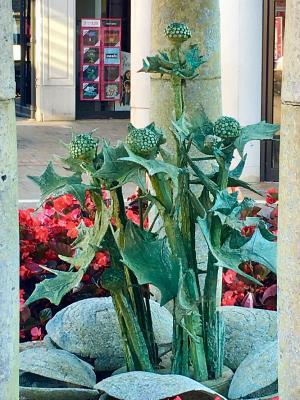

|
 The roots of Eringus or Eyringo, the Sea Holly (Eryngium maritimum), used as a food ingredient, as a vegetable, or, commonly candied as a, reputedly aphrodisiac, sweetmeat. Almost unknown now, Eringo occurs in all sorts of earlier receipts, in all sorts of guises. Robert May's Accomplisht Cook of the 1666s adds it to Chicken Pie, Potato Pasties and 'China Broth', while Francetelli in 1852 adds it to 'Sick-Diet Jelly' and the 1891 Encyclopedia of Practical Cookery uses it to flavour ass's milk. It is even known as a flavouring for 'Ebulum' beer.  Sea holly statue in the square at Colchester, celebrating the old eringo trade Image: Alex Bray... A particular speciality of Colchester in the 18th Century, but known at least since Shakespeare's 'Merry Wives of Windsor' in 1598. Plat 1609 recommends they be boiled then soaked in cold sugar syrup as "Rootes preserved in this manner, will eate ery tender." Murrell 1617 has it ground with almonds, pistachios and sugar, bound with rosewater, musk and ambergris.  Original Receipt in Plat 1609; Original Receipt in Plat 1609;1. How to preserve Eringo roots, Ænula Campana, and so of others in the same manner. Seethem them till they be tender: then take away the piths of them, and leave them in a colander till they have dropped as much as they will: then having a thin sirup ready, put them being cold into the sirup beeing also cold, and let them stand so three daies, then boyle the sirup (adding some fresh sirup to it; to supply that which the rootes have drunke up) a little higher: and at three daies end, boyle the sirup againe without any new addition, unto the full height of a preserving sirup, and put it in your rootes, and so keep them. Rootes preserved in this manner, will eate ery tender, because they never boyled in the sirup. Eringo is also referred to in: A Discourse of Sallets, 1699 A new system of domestic cookery, 1807 Cooks and Confectioners Dictionary, 1723 Encyclopedia of Practical Cookery, 1891 Eringo Gloucester Jelly Ling Pie Mary Eales's Receipts, 1718 Modern Domestic Cookery, 1819 Plain Cookery for the Working Classes, 1852 The Accomplisht Cook, 1660 The Closet of Sir Kenelm Digby, 1669 The Cook and Housekeeper's Dictionary, 1822 The Country Housewife and Lady's Director, 1728 The English Art of Cookery, 1788 The Experienced English Housekeeper, 1769 The Lady's Assistant, 1777 The London Art Of Cookery, 1811 The Practical Cook, 1845 The Queene-Like Closet, 1672  |
|
MORE FROM Foods of England... Cookbooks ● Diary ● Index ● Magic Menu ● Random ● Really English? ● Timeline ● Donate ● English Service ● Food Map of England ● Lost Foods ● Accompaniments ● Biscuits ● Breads ● Cakes and Scones ● Cheeses ● Classic Meals ● Curry Dishes ● Dairy ● Drinks ● Egg Dishes ● Fish ● Fruit ● Fruits & Vegetables ● Game & Offal ● Meat & Meat Dishes ● Pastries and Pies ● Pot Meals ● Poultry ● Preserves & Jams ● Puddings & Sweets ● Sauces and Spicery ● Sausages ● Scones ● Soups ● Sweets and Toffee ● About ... ● Bookshop ● Email: editor@foodsofengland.co.uk COPYRIGHT and ALL RIGHTS RESERVED: © Glyn Hughes 2022 BUILT WITH WHIMBERRY |